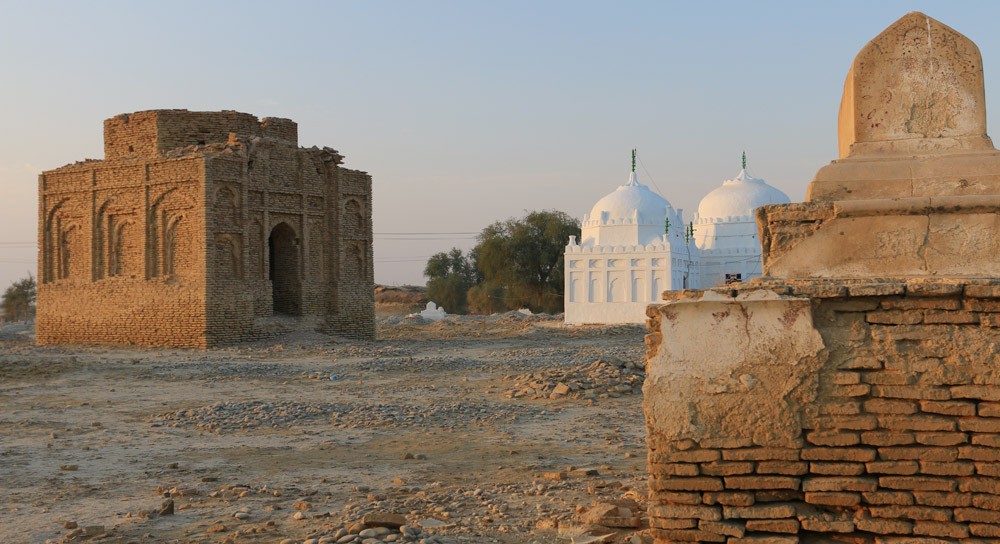
The tombs of Putt Suleman, like countless other monuments sprinkled across the outback of Sindh, must be preserved, else another part of Sindhi history will be lost forever

Something one cannot but fail to notice is the scenes of joie de vivre that blaze across 17th century and later funerary monuments in Sindh, whether carved in stone or painted. Here one sees processions of men accoutred with sword, shield, bow and arrow astride beautifully caparisoned horses with hookah-smoking attendants or dancing girls preceding them. Here we see hunting scenes and scenes from idyllic domestic life with the protagonist and his partner reposing on charpoys with beautifully carved and painted frames while well fed livestock stands about them.
On a recent drive through the outback of Dadu district, the late afternoon sun lit up a group of domed buildings that we had missed on the way out earlier that day. It was a sprawling graveyard collectively known as Putt Suleman ja Qubba - the Domes of Putt Suleman. The site contained two white-washed domes, one brick building with a collapsed dome, another intact. The fifth building, octagonal in plan, is commonly known as chhatri - canopy.
In the open was a large number of simple earthen burials of our times. There were, besides, a number of graves with raised plinths and adorned with stucco features shaped like charpoy legs on the four corners of the sepulchre. I have seen this to be a very common ornamental device in Sindhi burials and I believe it denoted the interred persons’ high rank. Judging from the use of identical bricks in the buildings and the burials outside, both appear to belong to the same period.
The white-washed tombs, similarly painted inside, had one and two graves respectively. But the chhatri is beautifully painted inside. Here we see a beautiful domestic scene with two feeding buffalos on either side of a charpoy with ornate legs. The middle part of the bed with two human figures has been scratched out so viciously that the bricks beneath are laid bare.
On another panel, we have a fish on a platter. But what is of greater interest is the rider on an ostentatiously caparisoned horse: floral saddlecloth on orange background with heavily tasselled stirrups, the tail and the braided mane of the horse decorated with baubles or flowers. Around the neck of the horse are elaborately worked halters. The rider with a sword and shield at his side is stabbing a leopard with a spear with streaks of blood below the stricken beast.
In yet another panel a well-groomed syce - orange shirt, dark brown or black tunic - with sword around his wasp waist and a shouldered matchlock, proudly steps out leading a camel by an exquisitely tasselled bridle. The figures on the camel have once again been very assiduously scratched out.
My friend Zulfiqar Kalhora, the finest anthropologist in the field today, tells me the white-washed tombs hold the mortal remains of Suleman Lund Baloch and his son Fakiro. Now the former was a fakir or spiritual follower of Mian Naseer Mohammad Kalhora who led a struggle for freedom from the Mughals between 1657 until his death in 1692. In recognition of his faithful service, Mian Naseer allotted him the putt or jagir where the graveyard stands and to this day the village is remembered as Putt Suleman.
Though the Mughals may not have sent a force this far out to try and tame the plucky Kalhora rebel and his devoted followers, we know that the Panhwar Rajputs of Sindh sided with the Mughals and did fight a number of battles against the Kalhoras and their followers. They who fell fighting under the banner of Suleman Fakir now sleep under the soil of Putt Suleman.
Zulfiqar Kalhora also tells me that Bukhsho Fakir, also a Lund Baloch and a disciple of Mian Naseer, lies buried under the chhatri with the beautiful frescos. He says that hunting scenes in his tomb do not only signify a hero but also a man of rank.
The fancy burials are reminders of those many struggles in the latter half of 17th century Sindh. They are therefore priceless pieces of Sindhi built heritage. But like the disfigured frescos, the charpoy legs fashioned on the corners of the simpler graves have all been smashed on purpose. While foolish individuals may have destroyed human depictions believing them to be against religious injunctions, the point of damaging the charpoy legs is beyond comprehension.
Among countless other monuments sprinkled across the outback of Sindh, the tombs of Putt Suleman are endangered. The danger comes not just from the malevolent hand of man but from Nature as well as rain and wind erode the priceless structures. If a move to preserve them is not made now, in a few years’ time only mounds of bricks will remain. Then another part of Sindhi history will have been lost forever.